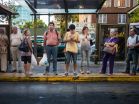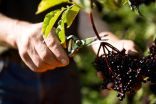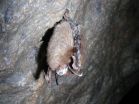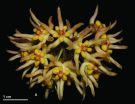(Press-News.org) WASHINGTON, DC, July 21, 2015 - It's not unusual for two drivers to depart from the same location, head out to the same destination, drive more or less the same speed and nevertheless arrive at dramatically different times, with one driver taking significantly longer to arrive. While this can simply be bad luck, sometimes the reason isn't an obvious external event.
And if you are a world traveler, you've likely noticed the fact that transportation works like a charm in some countries, in the sense that you can plan your commute or trip via public bus with confidence. The busses in some places will pick you up and drop you off at your destination in time and on schedule. Yet in other places, adherence to bus schedules is a complete mess.
While these two sets of observations may appear unrelated, they inspired a team of researchers in Colombia and Chile to explore the role of chaos in the dynamics of vehicles within cities. This week in the journal Chaos, from AIP Publishing, the team presents and analyzes the consequences of "discrete mapping" the exact evolution of a bus operating under ideal city conditions.
"Systems with chaotic dynamics have a very short time horizon for predictability -- which helps to explain scheduling problems with buses -- and trajectories that originate close to each other can have different behaviors," said Jorge Villalobos, the paper's lead author and the dean of the faculty of Natural Sciences and Mathematics at the Universidad de Ibagué in Colombia.
Several more elaborate models already exist for studying city traffic, but Villalobos and his team wanted to see what insights (intuitive or otherwise) they could find from a simple model, hoping that simplicity could lend some clarity to a complex and substantial issue.
To delve into these chaotic dynamics, the team built a very simple model of a bus that interacts with traffic lights and stops at a bus stop to pick up passengers between them. Think of it as a driverless bus -- being driven by a robot like a Google car. "We use it to explore under which conditions the interaction with traffic lights is chaotic or not. And to do this, we change the way the traffic lights change from red to green," said Villalobos.
A number called the "Lyapunov exponent" can be used to characterize chaos in a dynamical system. "If this number is positive, we have a chaotic system with low predictability," explained Villalobos. "We identify the combination of parameters -- basically the way the traffic lights behave -- for which we encounter positive Lyapunov exponents to identify situations for which the traffic lights make the bus trajectory chaotic and unpredictable in time or not."
To be more precise, if a bus in the team's model is in a chaotic trajectory, it would be extremely difficult to predict when it will arrive at a bus stop several traffic lights ahead. But, on the other hand, if the bus is on a non-chaotic trajectory it's easy to predict its arrival time.
Beyond being a fun way to help you scientifically back up and defend your beliefs at cocktail parties or wherever else you happen to find yourself debating the topic of whether or not traffic within cities is chaotic, the researchers' work shows that part of the problem is that, in some situations, bus or car trajectories are chaotic.
"Pretending to optimize bus systems -- in the sense of minimizing travel times -- is physically impossible," noted Villalobos.
"Chaos emerges when you have short waiting times at the bus stop and synchronize the traffic light to minimize traveling times," said Villalobos, describing one of the key findings of the paper. "On the other hand, if you force the bus to stop for long waiting periods and synchronize the traffic light to minimize traveling times you won't have chaos."
Looking at this from the perspective of someone trying to minimize the bus scheduling time, the team said that attempting to minimize the wait time will actually steer the system toward a chaotic -- unpredictable -- regime.
"Pretending to optimize bus systems -- in the sense of minimizing travel times -- is physically impossible," noted Villalobos.
The immediate applications for their findings are minimal, because they're studying a system with only one vehicle. "The biggest implication is that we show that chaos is an inherent part of city vehicle dynamics," said Villalobos.
As a next step, the team is exploring a slightly modified model that involves different types of driver behaviors, such as comparing calm drivers who brake slowly vs. aggressive drivers who brake abruptly. "We're working toward different ways of measuring our results in physical systems -- scaled or real systems -- and also exploring new models so that we can observe interactions between vehicles," added Villalobos.
INFORMATION:
The article, "Modeling a bus through a sequence of traffic lights," is authored by Jorge Villalobos, Victor Muñoz, José Rogan, Roberto Zarama, Juan Felipe Penagos, Benjamín Toledo, and Juan Alejandro Valdivia. It appears in the journal CHAOS on July 21, 2015. After that date, it can be accessed at: http://scitation.aip.org/content/aip/journal/chaos/25/7/10.1063/1.4926669
Authors of this study are affiliated with the Universidad de Ibagué, Universidad de Chile, CEDENNA, Universidad de los Andes and CEIBA.
ABOUT THE JOURNAL
CHAOS is devoted to increasing the understanding of nonlinear phenomena in all disciplines and describing their manifestations in a manner comprehensible to researchers from a broad spectrum of disciplines. See http://chaos.aip.org
The negative health effects of international air travel are well documented but now it seems that the common elderberry can provide some relief.
Associate Professor Evelin Tiralongo and Dr Shirley Wee from Griffith's Menzies Health Institute Queensland (MHIQ) have completed a clinical trial showing that an elderberry supplement can provide some protection from cold and flu-like symptoms following long-haul flights.
Intercontinental air travel can be stressful and affect a passenger's physical and psychological wellbeing. Whilst jet lag and fatigue remain the best known ...
WASHINGTON --Tamsulosin works no better than placebo on small kidney stones, but does improve passage of more large kidney stones than placebo does. The results of this large clinical trial evaluating tamsulosin versus placebo were published online Friday in Annals of Emergency Medicine ("Distal Ureteric Stones and Tamsulosin: A Double-Blind, Placebo-Controlled, Randomized, Multi-Center Trial (The DUST Trial)").
"Kidney stones bring more than a million Americans a year to emergency departments because they are excruciatingly painful," said lead study author Jeremy Furyk, ...
COLUMBUS, Ohio--Gravity data captured by satellite has allowed researchers to take a closer look at the geology deep beneath the Tibetan Plateau.
The analysis, published in the journal Nature Scientific Reports, offers some of the clearest views ever obtained of rock moving up to 50 miles below the plateau, in the lowest layer of Earth's crust.
There, the Indian tectonic plate presses continually northward into the Eurasian tectonic plate, giving rise to the highest mountains on Earth--and deadly earthquakes, such as the one that killed more than 9,000 people in Nepal ...
CHAMPAIGN, Ill. -- A microbe found in caves produces a compound that inhibits Pseudogymnoascus destructans, the fungus that causes white-nose syndrome in bats, researchers report in the journal Mycopathologia. The finding could lead to treatments that kill the fungus while minimizing disruption to cave ecosystems, the researchers say.
The yeast Candida albicans produces the compound: trans, trans-farnesol.
Candida species are already present in caves where bats hibernate and have been isolated from the bodies of healthy, hibernating bats, said University of Illinois ...
A clinical study funded by the National Institutes of Health has found that young, single black women in South Africa adhered to a daily pill regimen to prevent HIV infection--an HIV prevention strategy known as pre-exposure prophylaxis, or PrEP. This finding is the first strong indication that this population at substantial HIV risk could accept and reliably adhere to daily PrEP dosing. Men who have sex with men (MSM) and transgender women (TGW) in New York and Thailand also successfully adhered to daily dosing.
PrEP--which consists of a daily dose of two antiretrovirals, ...
Dr. Michele Rodda describes two new tropical plants species from the Hoya genus, found on the world's third largest island Borneo. The genus is one of the largest and most complex plant groups in Asia. The first to be described in the paper, H. ruthiae, is characterised with its lack of coloured milk-like sap typical for most of the Hoya species, and H. bakoensis - with its strict preference for growing epiphytically (without causing any harm to its host) and rooting inside ant nests. The study is published in the open-access journal PhytoKeys.
Collected by Ruth Kiew ...
URBANA, Ill. - Controlled burning is widely used to maintain biodiversity and enhance regeneration of important deciduous tree species such as oak and hickory, but a recent University of Illinois study found that this practice also increases the growth of an aggressive species of invasive grass.
Microstegium vimineum (also called Japanese stiltgrass or Nepalese browntop) is an abundant non-native grass in southern Illinois where the study was conducted.
"We found that fire promotes the recruitment and growth of M. vimineum, particularly under moist soil conditions," ...
Although much progress has been made in combating the global HIV/AIDS pandemic, to halt new infections and end the pandemic, a combination of non-vaccine and vaccine prevention modalities will be needed. Even with these tools, significant implementation gaps must be closed, including the targeted deployment of proven prevention methods to the populations that need them most, says Anthony S. Fauci, M.D., director of the National Institute of Allergy and Infectious Diseases at the National Institutes of Health. Dr. Fauci addressed a special session at the 8th International ...
Irvine, Calif., July 21, 2015 - The 11 percent decrease in climate change-causing carbon dioxide emissions in the U.S. between 2007 and 2013 was caused by the global financial recession - not the reduced use of coal, research from the University of California Irvine, the University of Maryland, and the International Institute for Applied Systems Analysis shows.
Experts have assumed that the drop in emissions reflected a shift toward natural gas, which produces roughly half as much carbon dioxide per unit of energy as coal and was made cheap by the hydraulic fracturing ...
Only one in three older Americans have their diabetes under control as measured by guidelines set by the American Diabetes Association, new Johns Hopkins Bloomberg School of Public Health research suggests.
Some argue that ADA guidelines may be too stringent for some older adults. But even using less stringent measures, the researchers found, there are still many older Americans whose diabetes is not well managed, a condition that can lead to multiple long-term health problems ranging from kidney disease to blindness.
In a report published in the July issue of Diabetes ...





